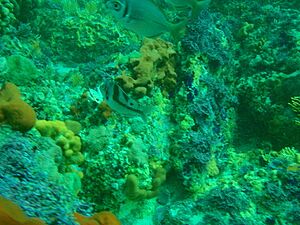Daggerhead seabream facts for kids
Quick facts for kids Daggerhead seabream |
|
|---|---|
 |
|
| Conservation status | |
| Scientific classification | |
| Synonyms | |
|
The daggerhead seabream (scientific name: Chrysoblephus cristiceps), also known as the dageraad, is a cool type of ray-finned fish. It belongs to the Sparidae family, which includes many seabreams and porgies. This special fish only lives in the waters off South Africa, in the southwestern Indian Ocean and southeastern Atlantic Ocean. Sadly, the International Union for Conservation of Nature says it's a Critically Endangered species, meaning it's in big trouble and needs our help to survive.
Contents
What's in a Name?
The daggerhead seabream got its first official scientific name, Chrysophrys cristiceps, way back in 1830. A French scientist named Achille Valenciennes described it. The name cristiceps comes from two Latin words: crista, meaning "crown," and ceps, meaning "head." This name refers to the raised, crown-like shape on the back of the head of adult male fish.
What Does It Look Like?
The daggerhead seabream has a deep, flat body. Its body depth is about half its total length.
Fins and Colors
- It has a dorsal fin (on its back) with 12 strong spines and 10 soft rays.
- Its anal fin (on its belly) has 3 spines and 8 soft rays.
- The top of its head curves inward between its snout and forehead. Then it gently rises to a hump before the dorsal fin starts.
- The fish's head and body are mostly red. The lower part of its body is a lighter red.
- All its fins are red.
- It has an orange gill cover and a faint blue stripe under its eye.
- You can spot a clear black mark at the back of its dorsal fin. There's also a dark spot at the base of its pectoral fin (the one behind its gills).
- Young daggerhead seabreams are pink. They have a red stripe along their sides and two blotches below their dorsal fin.
- This fish can grow up to 75 centimeters (about 30 inches) long. However, it's more common to see them around 40 centimeters (about 16 inches).
Where Do They Live?
The daggerhead seabream is found only in the waters off South Africa. Its home range stretches from Durban in KwaZulu-Natal to False Bay in the Western Cape.
Their Favorite Spots
- Adult daggerhead seabreams like to live on rocky reefs far from shore. They are found in waters between 20 and 100 meters (about 65 to 330 feet) deep.
- Younger fish prefer rocky reefs closer to the coast. They live in shallower waters, usually from 10 to 30 meters (about 33 to 100 feet) deep.
How Do They Live?
Scientists have studied daggerhead seabreams using tags. They found that adult fish usually stay in one area. However, they can move between different reefs if needed.
What They Eat and How They Grow
- This fish is a predator that lives near the bottom of the ocean. It eats many different kinds of small animals that live on the reef.
- The daggerhead seabream is a special type of hermaphrodite. This means it can change its sex during its life.
- They usually lay their eggs (spawn) between November and January.
- Sometimes, when the ocean water gets very cold, these fish will move to warmer areas.
Why Are They Endangered?
The IUCN has listed the daggerhead seabream as Critically Endangered. This means it's at a very high risk of disappearing forever.
Threats to Their Survival
- In the past, many daggerhead seabreams were caught by both commercial fishing boats and people fishing for fun.
- This fish grows slowly, lives a long time, and becomes an adult late in life. Also, because they tend to stay in one place and can change sex, they are very sensitive to overfishing. If too many are caught, their population can't recover quickly.
- Studies from the 1980s showed that their numbers had dropped a lot. Later studies confirmed that the population has not gotten better. This means we need even stronger rules to protect them.
How We Can Help
- Marine protected areas (MPAs) are like national parks in the ocean. They are very important for protecting the daggerhead seabream.
- Some key MPAs in their range include Tsitsikamma, De Hoop, and other MPAs near East London. These protected areas help give the fish a safe place to live and reproduce.


